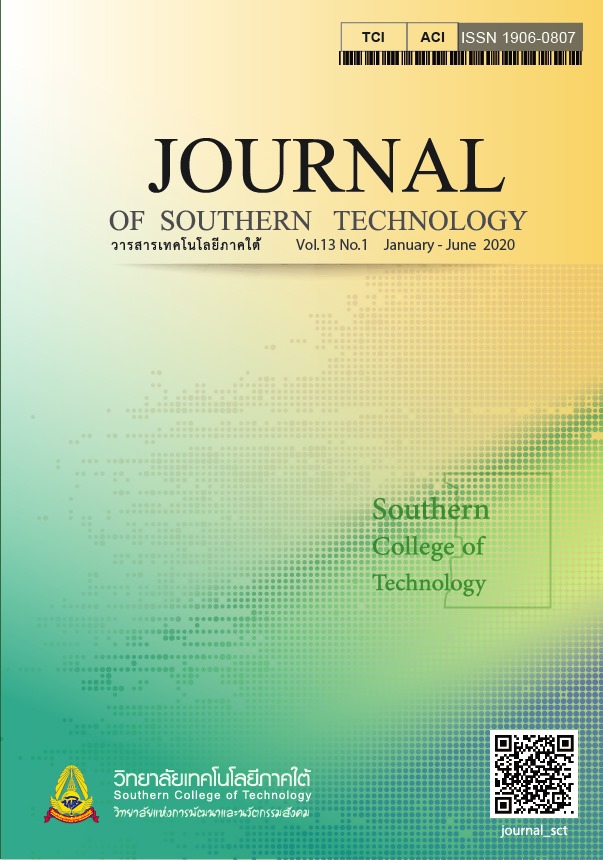Safety Performance of the Construction Works in Thailand
Main Article Content
Abstract
The objectives of this research were to study safety management models and methods of construction works in Thailand, and factors affecting safety awareness and efficiency of safety construction in Thailand. The study used in-depth interviews of 16 key informants including owners, managers, staff, and assigned individuals from construction companies. A sample of 400 people was selected through stratified sampling from the population of foremen, technicians, technician assistants, and workers completed a questionnaire in the study. Results showed that there are 4 models of safety management for construction in Thailand. They are safety management model in the form of foreign corporations are main contractors, of Thai corporations, of Thai corporations as sub-contractors and of Thai individual sub-contractor. It was suggested that safety management could be enhanced through compliance with construction rules and regulations and corporation. Factors affecting contractors’ safety awareness and performance include those that are related to situation, individual and their associates. Findings of this study offer insights to construction companies and concerned parties on factors affecting safety awareness so that they can appropriately apply the models and suggestions in their organization.
Article Details
-
Authors must agree to the journal publication rules and allow the editors to edit the manuscripts for publication.
-
Author’s right belongs to the author but Journal of Southern Technology holds the right of first publication and thus allow readers to use the article for the purpose of education but not commercial.
References
Ahonen, E., Benavides, F.G., Benach, J. (2007). Immigrant populations, work and health-a systematic literature review. Scandinavian Journal of Work, Environment & Health, 33(2), 96-104.
Asia and the Pacific International Labour Organization. (2016). Promotional Framework for Occupational Safety and Health Convention, 2006. Ministry of Labour. [in Thai]
Biggs, S. E., Banks, T. D., Davey, J. D., & Freeman, J. E. (2013). Safety Leaders’ perceptions of safety culture in a large Australasian Construction Organisation. Safety Science, 52, 3-12.
Caponecchia, C., & Sheils, I. (2011). Perceptions of personal vulnerability to workplace hazards in the Australian Construction Industry. Journal of Safety Research, 42, 253-258.
Christian, M. S., Wallace, J. C., Bradley, J. C., & Burke, M. J. (2009). Workplace safety: A meta-analysis of the roles of person and situation factors. Journal of Applied Psychology, 94(5), 1103-1127.
Department of Labour Protection and Welfare. (2016). Number of Establishments as November 25, 2016. Ministry of Labour. [in Thai]
Hamalainen, P., Takala, J., & Saarela, K. L. (2006). Global estimates of occupational accidents. Safety Science, 44, 137-156.
Hasle, P., & Limborg, H. J. (2006). A Review of the litrature on preventive occupational health and safety activities in small enterprises. Industrial Health 2006, 44, 6-12.
Health and Safety Executive. (2016). Statistics on Fatal Injuries in the Workplace in Great Britain 2016. National Statistics. pp.1-16.
International Labour Organization (ILO). (1988). Safety and health in construction convention. Information System on International Labour Standards, 167, 1-9.
International Labour Organization (ILO). (2016). Vision Zero Fund. United Nations.
Jarukkhamool, S., & Chaiklieng, S. (2014). Perception of occupational health hazards and injuries among construction workers: a case study of residential construction Company. KKU Research Journal, 19(5), 683-695. [in Thai]
Laohaudomchok, W. (2016). Vision Zero: A Global Strategy and Safety at Workplace. Occupational Safety and Health Division: Ministry of Labour. [in Thai]
Ministry of Industry. (2016). Thailand Industry Development Strategy 4.0. Ministry of Industry. [in Thai]
National Statistical Office. (2010). The 3rd Construction Industry Survey, 2009. National Statistical Office. [in Thai]
Occupational Safety and Health Bureau. (2012). Occupational Safety and Health National Plan (2012-2016). Department of Labour Protection and Welfare. Ministry of Labour. [in Thai]
Sawacha, E., Naoum, S., & Fong, D. (1999). Factors affecting safety performance on construction sites. Pergamon Internal Journal of Project Management, 17(5), 309-315.
Srimarut, T. (2012). Safety Behavior in the Operation of the Production Staff in the Practitioner Level. Suan Sunandha Rajabhat University Research Grant for Fiscal Year 2012. [in Thai]
Takala, J. (1999). Global estimates of fatal occupational accidents. Epidemiology, 10(5), 640-646.
Thailand Institute of Occupational Safety and Health (Public Organization). (2016). Zero Accident Campaign 2016. Ministry of Labour. [in Thai]
Wichairum, S. (2009). Risk Factors of Construction Workers (Master's Thesis). Dhurakij Pundit University. Bangkok., Thailand. [in Thai]
Worasakdapisarn, E. (2014). Relationship of Safety Management Factors and Safety Performance in Building Construction Project (Master's Thesis). Suranaree University of Technology, Nakhon Ratchasima.,Thailand. [in Thai]
Workmen’s Compensation Fund Office. (2015). Situation of Danger and Illness due to works of 2011-2015, Type of Construction Business. Social Security Office. Ministry of Labour. [in Thai]

